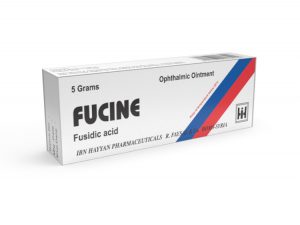


Composition and excipients:
Each 1g Fucine ointment contains:
Each 1g Fucine cream contains:
Indications:
Indicated either alone or in combination with systemic therapy, in the treatment of primary and secondary skin infections caused by sensitive strains of Staphylococcus aureus, Streptococcus spp and Corynebacterium minutissimum. Primary skin infections that may be expected to respond to treatment with fusidic acid applied topically include: impetigo contagiosa, superficial folliculitis, sycosis barbae, paronychia and erythrasma; also such secondary skin infections as infected eczematoid dermatitis, infected contact dermatitis and infected cuts/abrasions.
Dosage and administration:
Adults and Children:
Uncovered lesions: apply gently three or four times daily.
Covered lesions: less frequent applications may be adequate
Contraindications:
Hypersensitivity to the active substance or to any of the excipients.
Warnings and precautions:
Drug interactions:
Interactions with systemically administered medicinal products are considered minimal as the systemic absorption of topical fusidic acid is negligible.
Pregnancy:
No effects during pregnancy are anticipated, since systemic exposure to topically applied fusidic acid/sodium fusidate is negligible. Topical fusidic acid can be used during pregnancy.
Breast-feeding:
No effects on the breast-feeding babies are anticipated since the systemic exposure of topically applied fusidic acid/sodium fusidate to the breast-feeding woman is negligible. Topical fusidic acid can be used during breast-feeding but it is recommended to avoid applying it on the breast.
Undesirable effects
The most frequently reported adverse reactions during treatment are various skin reactions such as pruritus and rash, followed by application site conditions such as pain and irritation, Hypersensitivity and angioedema have been reported
Other effects:
Skin and subcutaneous tissue disorders: Uncommon: Dermatitis (contact dermatitis, eczema) Rash (such as erythematous, pustular, vesicular, maculopapular , papular and rash generalized), Pruritus, Erythema.
General disorders and administration site conditions: Uncommon: Application site pain (skin burning sensation), application site irritation.
Overdose:
Overdose is unlikely to occur unless hypersensitivity to Fusidic acid or any of the excipients exists, accidental ingestion of the cream or the ointment is unlikely to cause any harm. The total quantity of fusidic acid will usually not exceed the approved total daily oral dose of fusidic acid containing products except in children aged less than 1 year and weighing ≤ 10 kg. The concentration of the excipients is too low to constitute a safety risk.
Storage conditions: Store between 15° and 25°C.
How supplied :
Fucine ointment: Tube containing (20-40) grams ointment.
Fucine Cream: Tube containing 20 grams Cream.

Composition and excipients:
Each 1g Fucine ointment contains:
Each 1g Fucine cream contains:
Indications:
Indicated either alone or in combination with systemic therapy, in the treatment of primary and secondary skin infections caused by sensitive strains of Staphylococcus aureus, Streptococcus spp and Corynebacterium minutissimum. Primary skin infections that may be expected to respond to treatment with fusidic acid applied topically include: impetigo contagiosa, superficial folliculitis, sycosis barbae, paronychia and erythrasma; also such secondary skin infections as infected eczematoid dermatitis, infected contact dermatitis and infected cuts/abrasions.
Dosage and administration:
Adults and Children:
Uncovered lesions: apply gently three or four times daily.
Covered lesions: less frequent applications may be adequate
Contraindications:
Hypersensitivity to the active substance or to any of the excipients.
Warnings and precautions:
Drug interactions:
Interactions with systemically administered medicinal products are considered minimal as the systemic absorption of topical fusidic acid is negligible.
Pregnancy:
No effects during pregnancy are anticipated, since systemic exposure to topically applied fusidic acid/sodium fusidate is negligible. Topical fusidic acid can be used during pregnancy.
Breast-feeding:
No effects on the breast-feeding babies are anticipated since the systemic exposure of topically applied fusidic acid/sodium fusidate to the breast-feeding woman is negligible. Topical fusidic acid can be used during breast-feeding but it is recommended to avoid applying it on the breast.
Undesirable effects
The most frequently reported adverse reactions during treatment are various skin reactions such as pruritus and rash, followed by application site conditions such as pain and irritation, Hypersensitivity and angioedema have been reported
Other effects:
Skin and subcutaneous tissue disorders: Uncommon: Dermatitis (contact dermatitis, eczema) Rash (such as erythematous, pustular, vesicular, maculopapular , papular and rash generalized), Pruritus, Erythema.
General disorders and administration site conditions: Uncommon: Application site pain (skin burning sensation), application site irritation.
Overdose:
Overdose is unlikely to occur unless hypersensitivity to Fusidic acid or any of the excipients exists, accidental ingestion of the cream or the ointment is unlikely to cause any harm. The total quantity of fusidic acid will usually not exceed the approved total daily oral dose of fusidic acid containing products except in children aged less than 1 year and weighing ≤ 10 kg. The concentration of the excipients is too low to constitute a safety risk.
Storage conditions: Store between 15° and 25°C.
How supplied :
Fucine ointment: Tube containing (20-40) grams ointment.
Fucine Cream: Tube containing 20 grams Cream.

Composition :
Each 1g of FUCINE ophthalmic ointment contains: Fusidic Acid 10 mg.
Pharmacological Properties:
FUCINE (Fusidic Acid) eye-ointment is a broad spectrum antibiotic which is active against a wide variety of susceptible micro-organisms including staphylococcus, streptococcus, Neisseria, Moraxella, and corynebacteria.
FUCINE eye-ointment penetrates well into the aqueous humour, and a twice daily application provides sufficient concentrations in all relevant tissues of the eye.
Indications:
FUCINE ophthalmic is used in the treatment of bacterial eye infections caused by susceptible organisms in conjunctivitis, blepharitis, sty, keratitis, dacryocysitis, and in connection with removal of foreign bodies.
Contra Indications and Precautions:
-Hypersensitivity to any of the components.
– Should not be used when contact lenses are being worn.
Side Effects:
Transient stinging may occur, FUCINE has a very low allergic potential.
Dosage and Administration:
Apply into conjunctival sac twice daily. Treatment should be continued for at least two days after the eye appears normal.
Packing: Tube of 5 mg.
Storage Conditions: Store at temperature below 25 º C.